A Terrorist attack on the Kakhovka Hydroelectric Power Plant: Dnipropetrovsk region is dying without water
After the Russians blew up the dam of the Kakhovka reservoir, the riverside of Dnipro became a site of environmental disaster. While one part of the region is being flooded, another part is being destroyed by the lack of water. Immediately after the terrorist attack, the level of the upstream Dnipro began to drop rapidly, draining water from the canals, lakes, and floodplains fed by it. After visiting Zaporizhzhia, we traveled along the riverbank to the Dnipropetrovsk region. Read the Donbas Frontliner’s report on how the communities on the Dnipro riverside are surviving.
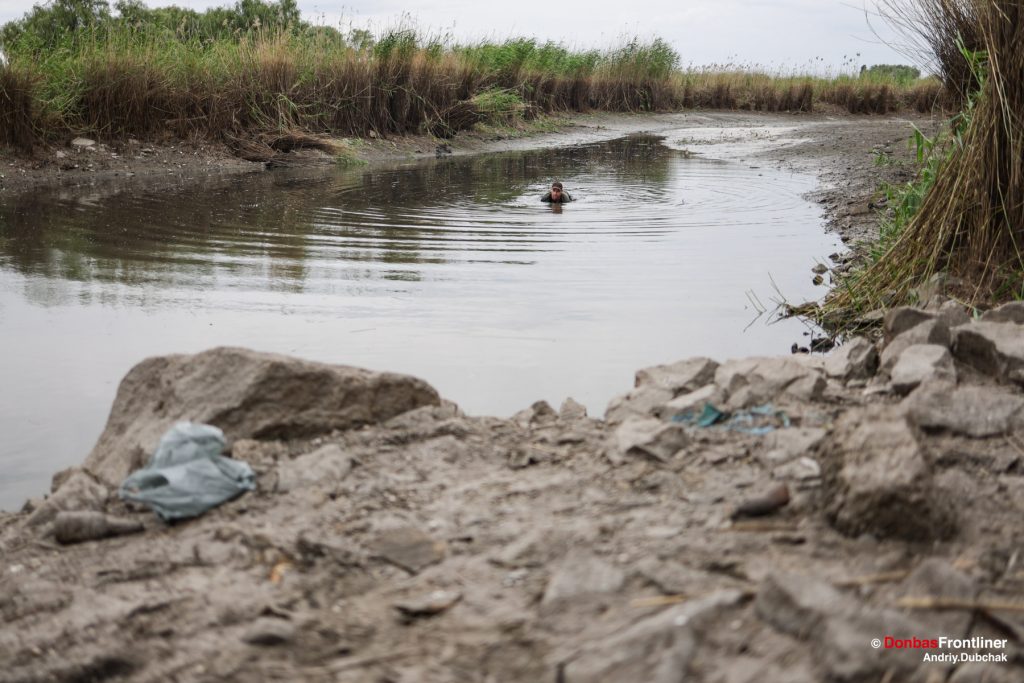
We leave Zaporizhzhia and drive along the bank of the Dnipro towards the Dnipropetrovsk region. The road takes us through Bilenke, a village on the border between two regions. Just a few days ago, a river flowed under the bridge here. Now it is a trickle amid a dried-up moonscape with a dirty, knee-deep puddle in the middle. A man is rooting around in this puddle, trying to catch the last fish. “At least the cat gets this,” he says, pulling two small fish out of his pocket as water, black as fuel oil, trickles down his body.
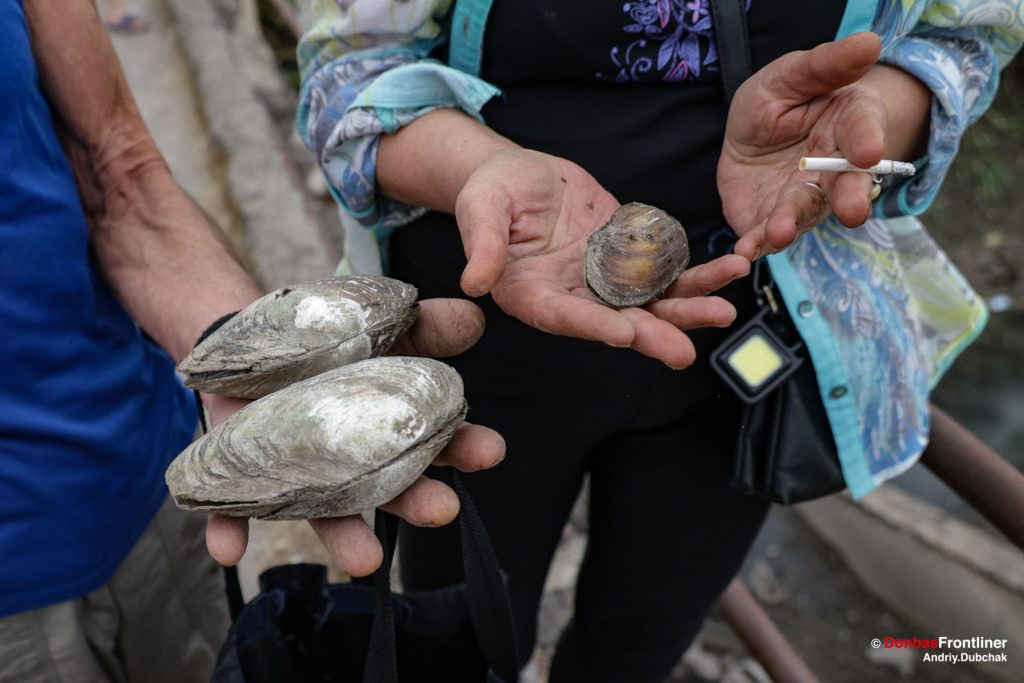
A couple standing on the bridge watches him. A man and a woman are on their way home. They were picking shells and mussels, still alive, in the shallow riverbed. The water has receded, but the mollusks did not have time to escape and remained stuck in the sand. Now the couple will release them in their own pond. “A neighborhood boy brought me a little turtle yesterday,” the man says, pointing to the dry river channel. “He found it right here. ‘Will you take it?’ he asked me. He knows I have a pond. Of course, I took it, why wouldn’t I?” The water level in Bilenke dropped three to four meters [as of June 10]. But you can still get it from boreholes and wells.
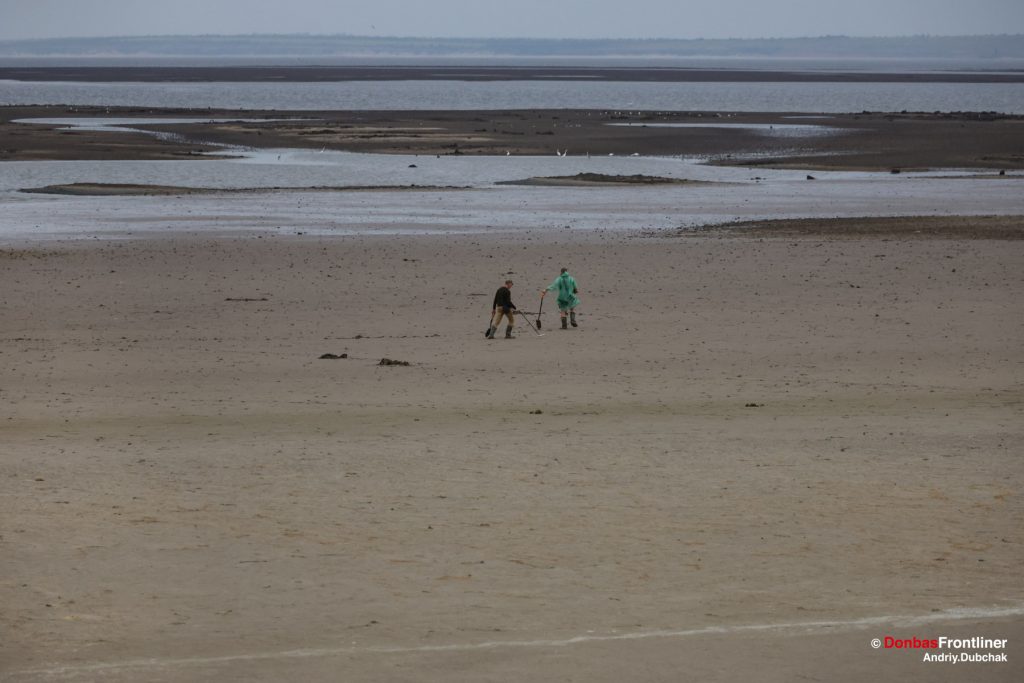
The further downstream we travel, the more problems people have with the water supply. And also with shelling. The village of Vyshchetarasivka is shelled almost every night—it is too close to Enerhodar. There is no water here, just like in neighboring Chervonodniprovka. The Dnipro used to be 12 meters deep here—now it’s only three. “Rascists could just cross it on foot if they wanted to,” Olha, a local, says worriedly.
“Let me put it this way: I’d rather live without water than in Russia”
The water supply situation is under control in the larger cities on the banks of the Dnipro—for example, in Marhanets or Nikopol. Water distribution stations have been set up more or less evenly across the neighborhoods. There are 24 such stations in Nikopol [as of June 12], and the city administration plans to open more. They are mostly located in school and kindergarten yards and are open all day, from 6 a.m. to 9 p.m.—until curfew.
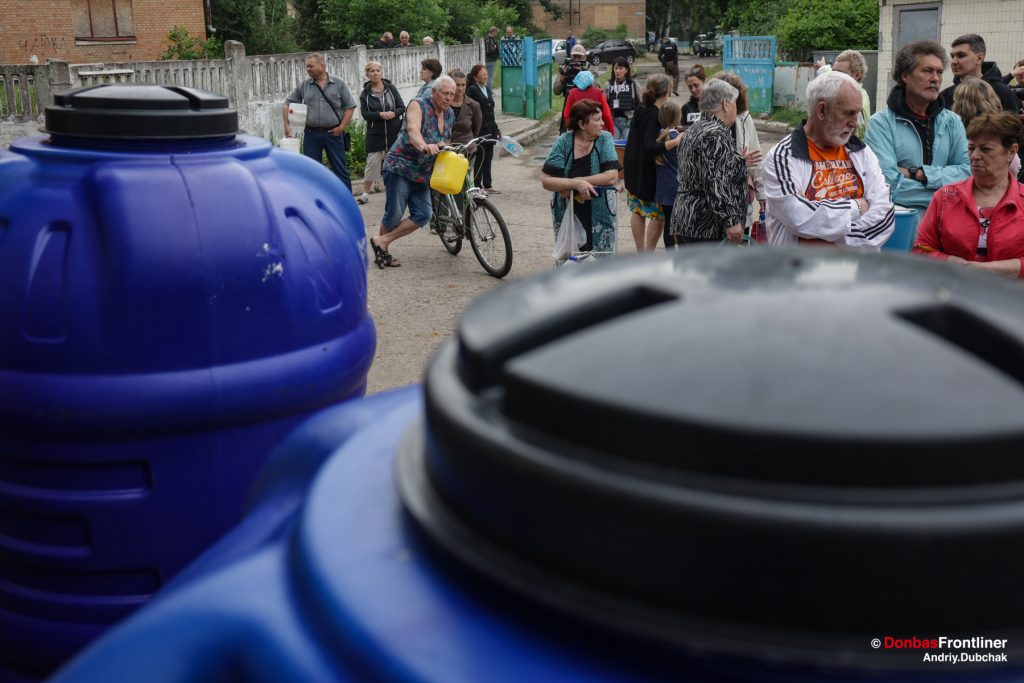
The setup looks simple: two large plastic water tanks with taps, each with a capacity of 1,000 liters. People line up and fill their own bottles and canisters with water. They must boil it before drinking. There is no set limit yet, but people are asked to take no more than 10 liters per person. School staff monitors the process: they guard the tanks at night and notify the municipality if the water runs low earlier than expected. Trucks usually bring water and refill the tanks every two hours.
“This is my first time today,” Valentyna says. She lives in an apartment in a nearby building. “I thought I might as well fill this bottle with water now that it’s empty.”
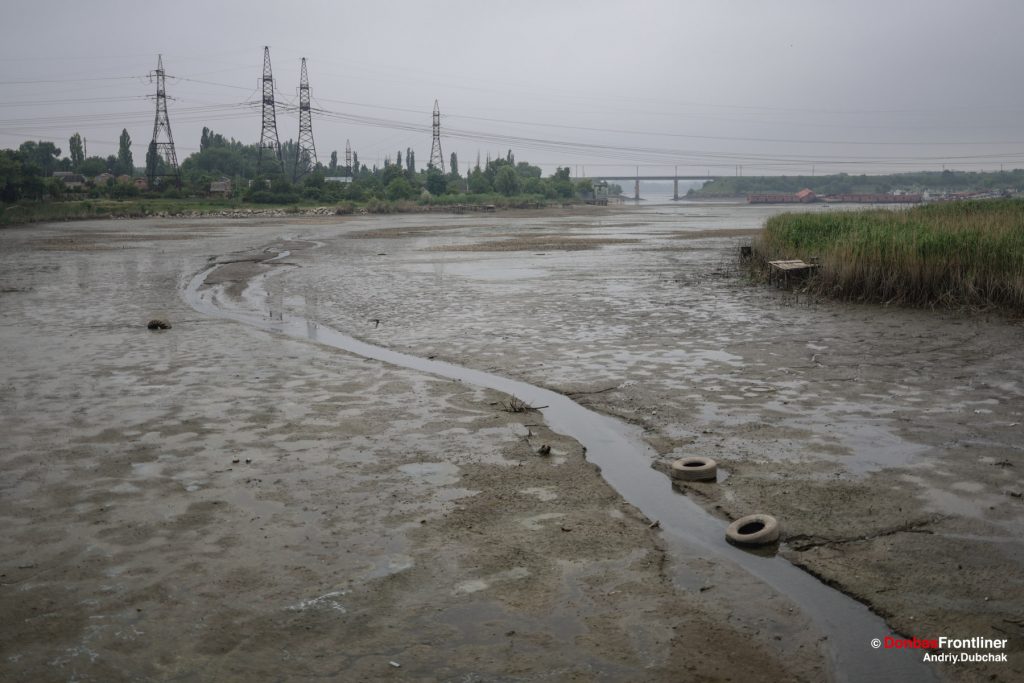
“And it’s my second time. I already got water at eight in the morning. No one was here then,” says her neighbor Halyna Semenivna. “It’s hard without water, you know. We are eight people in the apartment, three adults and five children. It’s really hard, we need a lot of water. We haven’t planted anything and wouldn’t know what to do with it if we had.”
“And I planted flowers. But I didn’t water them—there was no water. Thank God, it was raining. I also collected some rainwater to flush the toilet.”
“I collected some under the roof yesterday, but it’s so black I can’t use it. I’m even disgusted to flush the toilet with it.”
“You must have collected it right away. You should’ve waited until the dust was washed away.”
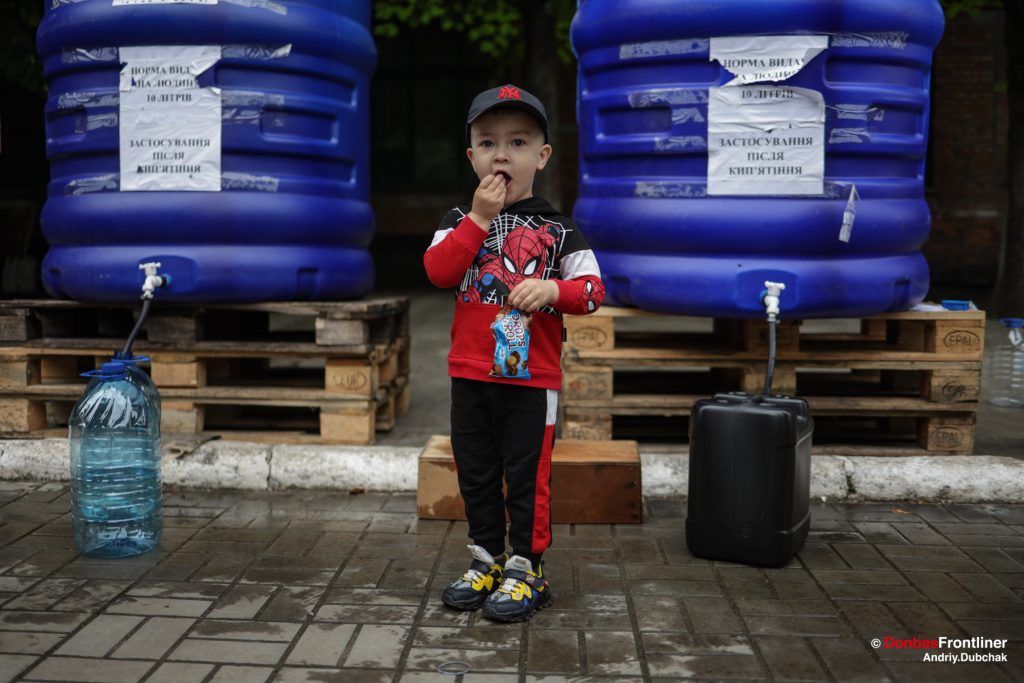
Since June 10, there is no tap water. The city government has warned people that this could continue for a long time and that they should have at least a three-day supply. Information about water distribution stations is updated on social media. The queues are not very long at the moment—up to twenty people, but sometimes there can be up to fifty. They are mostly seniors and families with children. They exchange news and tips.
“Living in a block of flats with a sewage system is difficult. You need a lot of water. If the sewer gets clogged, we’re done for,” Natalia says.
“And the stench!” grumbles Halyna Semenivna. “I live on the third floor. I go to the kitchen and smell the odor from the bathroom.”
“I found a solution,” says Natalia. “I poured bleach into a detergent sprayer and spray it inside the toilet bowl once a day.”
“We hope they’ll fix it and that it’s just a temporary problem. We Ukrainians are not desperate,” Halyna Semenivna adds.
“Yes, I would like it to be over soon. My son fought during the anti-terrorist operation and is now serving in the Armed Forces of Ukraine,” Valentyna says. Her voice trembles, and tears well up in her eyes. She turns and quickly walks away without saying goodbye.
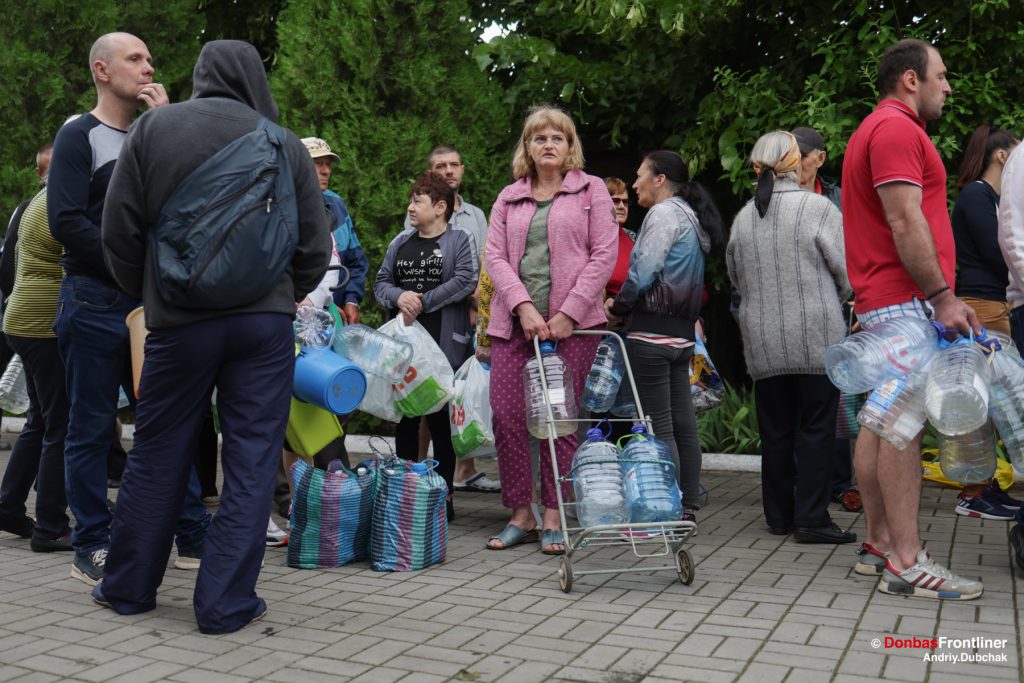
On June 12, it was eleven months since the Russian troops had been shelling Nikopol. Chaotically, almost every day, from the direction of the Zaporizhzhia nuclear power plant. During this time, 16 residents of the city were killed and 135 wounded. Over 4,000 buildings were damaged. Before the full-scale invasion, 105 thousand people lived here. Now there are less than half of them. However, after the liberation of Kherson, many people returned to the city. And people are holding on to their land even now, after the Russians blew up the Kakhovka dam.
“It’s hard to go anywhere without money. You have to feed your children. We took our kids to Kamyanske—it’s not that far away. But it’s very hard emotionally to be somewhere else when I have everything here and nothing there,” Olena says. She works at the kindergarten and supervises one of the water distribution stations.
“The children have returned to the neighborhood,” adds a man next to her. “Two months ago or so. I wondered about the strange noises I heard —turned out it was kids playing on the playground again. And what are they going to do now when there’s no more water? They’ll go away again, I suppose.”
We overhear someone nearby saying something like, “Let me put it this way: I’d rather live without water than in Russia.”
In addition to the shelling and the lack of water, there is another major threat that the whole city is talking about: the Zaporizhzhia nuclear power plant, which is a danger now that the water level in the Dnipro has dropped. People are anxiously discussing the news they find on TV, on the Internet, and social media, sharing their own theories and predictions.
“The nuclear power plant has always been our neighbor. And it is a constant threat, not only in times of war,” says Oleksandr Sayuk, mayor of Nikopol, when asked about people’s fears. “I have no idea whether the Russians will do it [a terrorist attack on the Zaporizhzhia nuclear power plant]. We can’t do anything about it. We have no contacts there and get all the information from Energoatom. There is an evacuation plan. We’ll see. We got used to all sorts of things. I didn’t believe until the last second that they’ll do something like this [blow up the dam]. It’s an environmental disaster. But is there anything to say? Nothing can surprise us anymore because we know what kind of country we are dealing with. We’ll hold it out.”
The road along the Dnipro offers a somewhat disturbing and dismal view of the Zaporizhzhia nuclear power plant: on the opposite bank—ten kilometers away as the crow flies—the stretches of recently exposed riverbed come very close to the power plant units.
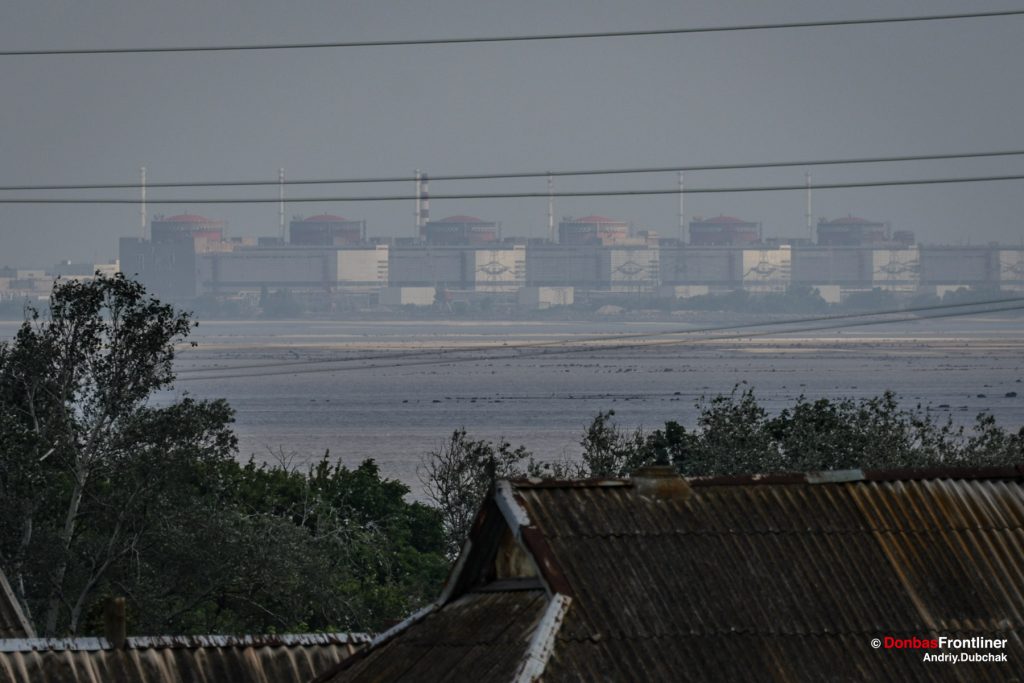
Occupation, shelling, shallow water
The farther downstream we drive, the more catastrophic the sight before our eyes becomes, and the more difficult it gets for coastal communities to survive. Part of the road—from Naberezhne to Hrushivka—offers a clear view of the river. Perhaps this is the best place to see the extent of the disaster: The dried-up riverbed stretches for hundreds of meters. Locals say the water here has receded by more than a kilometer [as of June 12].
Hrushivka is a village of vineyards—every second house has a small plantation in the backyard. People grow grapes for sale. Yulia says the grapes need to be irrigated at least once a week to grow well and bear fruit. A system of pipes was installed to draw water directly from the Dnipro. They used it to irrigate the grapes when there was still access to water. But this is no longer the case. There is now neither utility water nor drinking water in the village.
The villagers’ only salvation is the well and the supply they created when the water still flowed from the tap. “They said they would distribute the water, but it’s unclear when and how they will organize it,” Yulia says. “It’s just shocking. My husband woke me up in the morning [the day of the terrorist attack] and broke the news, but I could not understand a word. We knew something like this could happen. But knowing a thing and seeing it actually happen is something completely different.”
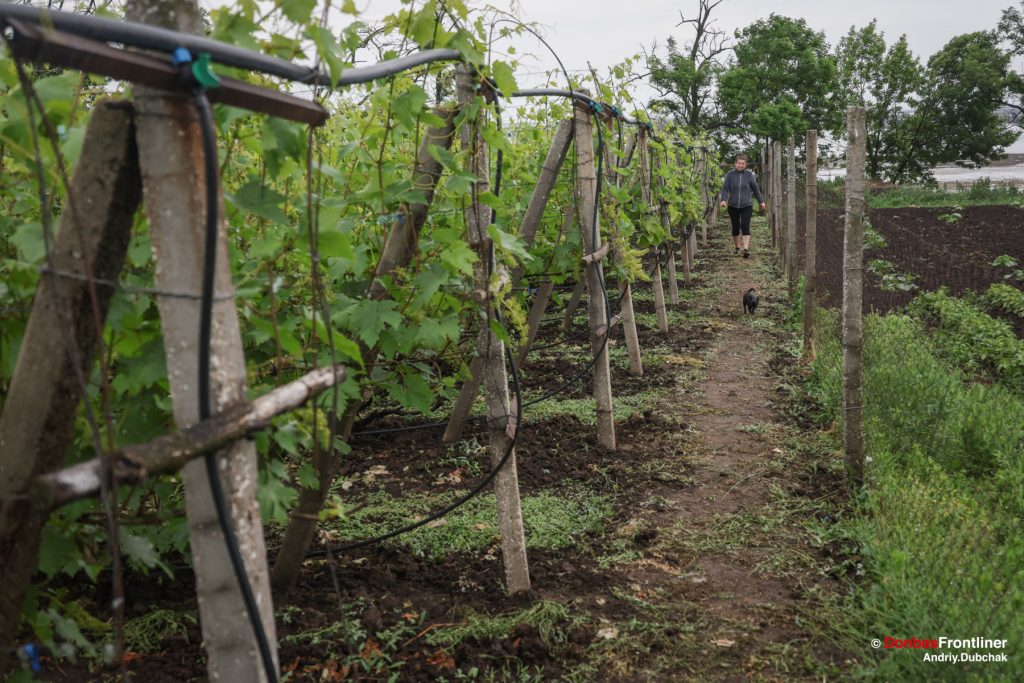
She came here with her family from Dudchany, a village a little further downstream that used to be occupied and now lives under constant shelling by Russian troops and without water. She says, “There have been no rocket attacks here. People joke that we don’t get shelled because the village used to have a different name, Leninske. Had it been called Zelenske, they would’ve bombed it to pieces. There is shooting on this side and shelling on that side. We’ve been sitting here like on an island.”
Yulia and her husband have three young children. Hrushivka has been their third home since the full-scale invasion began, and their home village of Dudchany was occupied. “We’ve been roaming from place to place for over a year. We don’t want to go abroad. No, we just do not. We want to live in Ukraine and go home,” she says. And after a moment’s thought, she adds, “But now I’m no longer sure. It would be best for the children if we just took them abroad. I think about Enerhodar all the time. What should we do? Where should we flee to? There was some hope, but that’s over after the dam was blown up.”
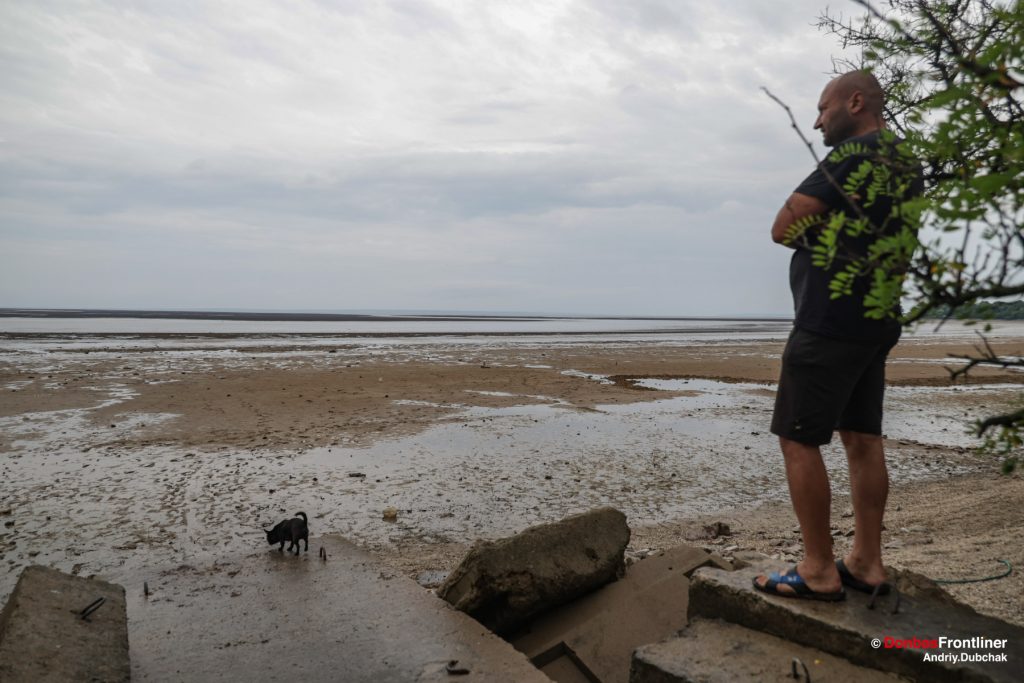
Hrushivka is followed by Maryanske, the last village on the border with the Kherson region. The peculiarity of Maryanske is that it was built on both banks of the deep floodplain of the Dnipro. And when the water receded, most of the fish stayed behind.
“On the second day, we went to the floodplain—and there were so many fish,” Yulia’s husband says as Yulia shows us a video of the fish strewn about the riverbed. “The water drained, but the puddles remained. The fish could not get over the bump and swim downstream. People gathered around half, but most of it just stayed put. It was painful to watch the little fish flounder on their sides.”
The dead fish is still there four days later. The National Police stationed a guard to keep the locals from collecting it. We meet him by the river. “People come and ask, ‘But it’s for the pigs. Why don’t you let us pick it?’ They see it as free feed for the animals. So I explain to them how it works and what diseases it can cause. I tell them to read about it on the Internet, and only then do they agree that it makes sense,” says the police officer. He adds that so far Maryanske has been the only place in the district where there is a massive fish kill.
“If we chased them [the Russians] out of Kakhovka, we would solve the problem quickly,” says Mykola, a technician at a local pumping station. “All you have to do is build a cofferdam here and let the water rise two or three meters. It will quickly come back. It’s shallow here, that’s why the water has receded so far.”
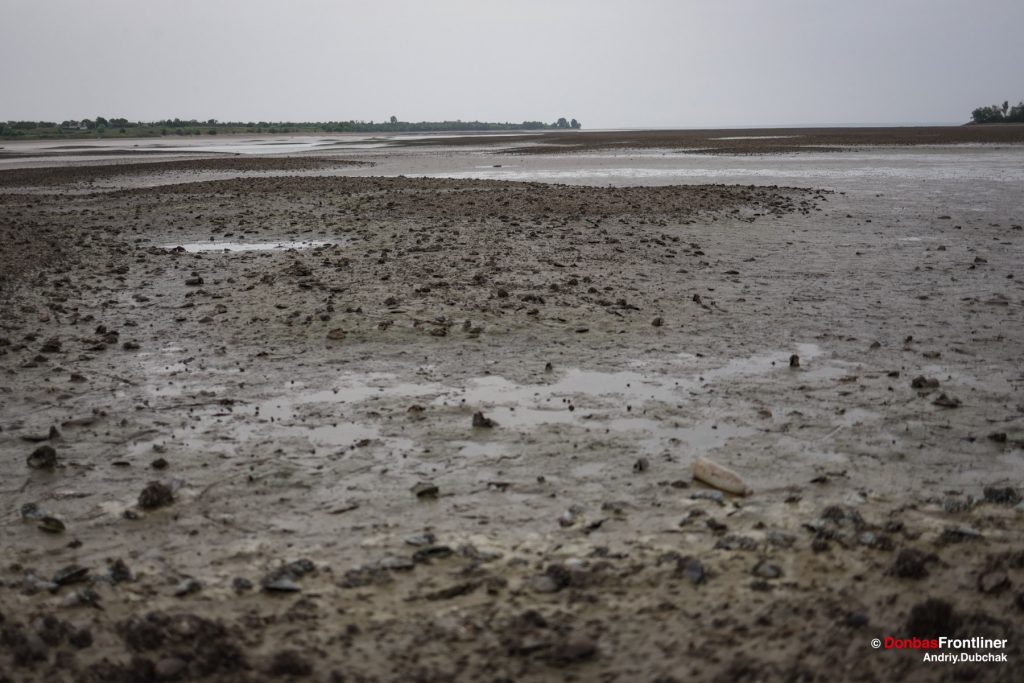
He leads us to the shallow bank: as far as the eye can see, stretches of exposed riverbed rising out of the water are visible on the horizon. In the distance, about 350 meters away, there is a water pump in the sand that pumped utility water into the village. “It hasn’t been able to draw water for five days,” Mykola says. “We have built up a supply, but it’s not big—people would only have enough to give to their cows to drink for three days. We came here yesterday. We were going to bring in an excavator and dig a pit to install a pump. So we made a mark, but by morning the water had receded even more. Last night, that big stretch of the riverbed was not even visible. The water level just keeps falling and falling and won’t stop.”
Villagers say volunteers brought some water, but it was not nearly enough for everyone: “Tomorrow, they’ll distribute five liters per person. But it’s unclear how long those five liters are supposed to last—a day, two days, a month.”
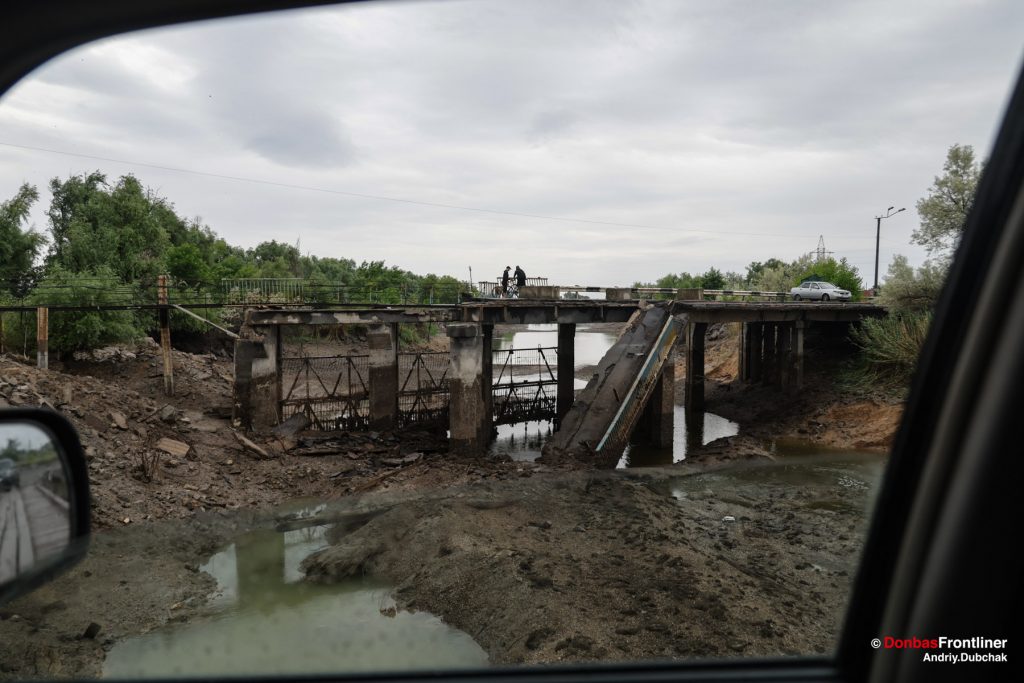
Mykola lives with his wife and son near the pumping station by the river. His family tree is rooted here.
“You have good soil here,” I tell him.
“It’s really good,” he says, then adds, “When there’s water. My father survived the flooding[1]. I survived the receding. So this is the soil for you. No water—no soil. Everything I planted will burn in the sun and die. My wife roams the house crying. I’ve lived here all my life and run a household, and now what? To abandon everything and leave. Someone’s house was flooded and destroyed in an instant, and now they have to come to terms with the fact that it [the household] no longer exists. My household is intact, but it won’t survive without water, either.”
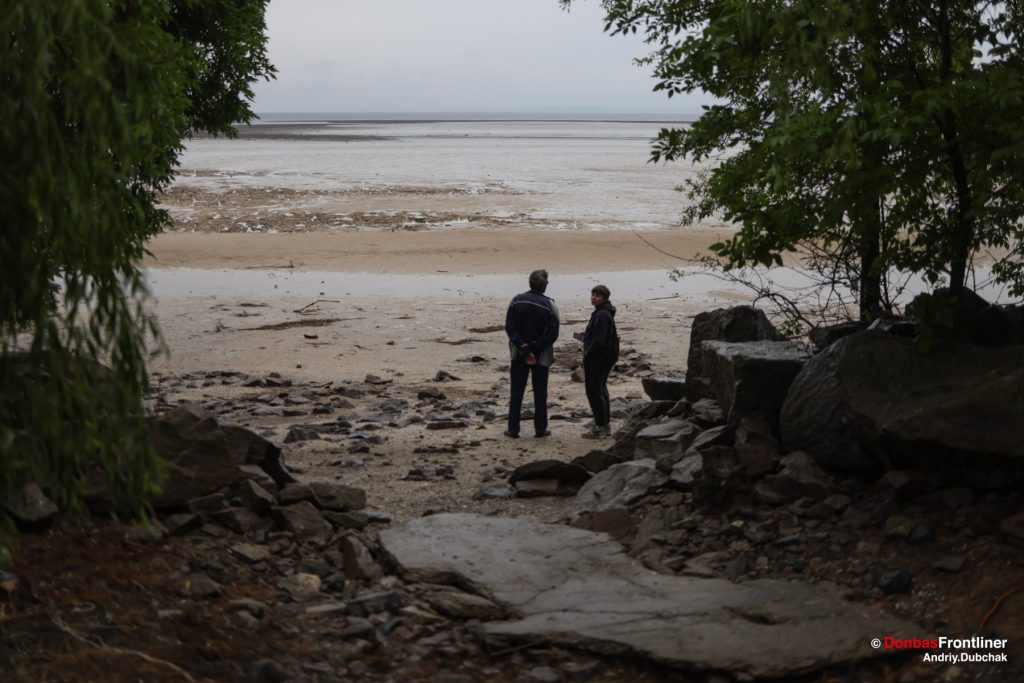
Up to half of the population of Maryanske left the city during the massive shelling by the Russians. After the liberation of Kherson, there were no more attacks here, but at night people hear explosions in the nearby villages of Osokorivka and Zolota Balka. Mykola says they can also see rockets being fired from Grad multiple rocket launchers on the other bank of the Dnipro.
Just outside Maryanske, the Kherson region begins. As a result of the terrorist attack on the Kakhovka dam, this part of the region was not flooded but drained. Novovorontsovka is the first village on this side. It has not been occupied but has suffered badly from Russian shelling. According to the locals, they can see many missiles now that the water has receded. Access to the riverbank is restricted, and mine warning signs are everywhere.
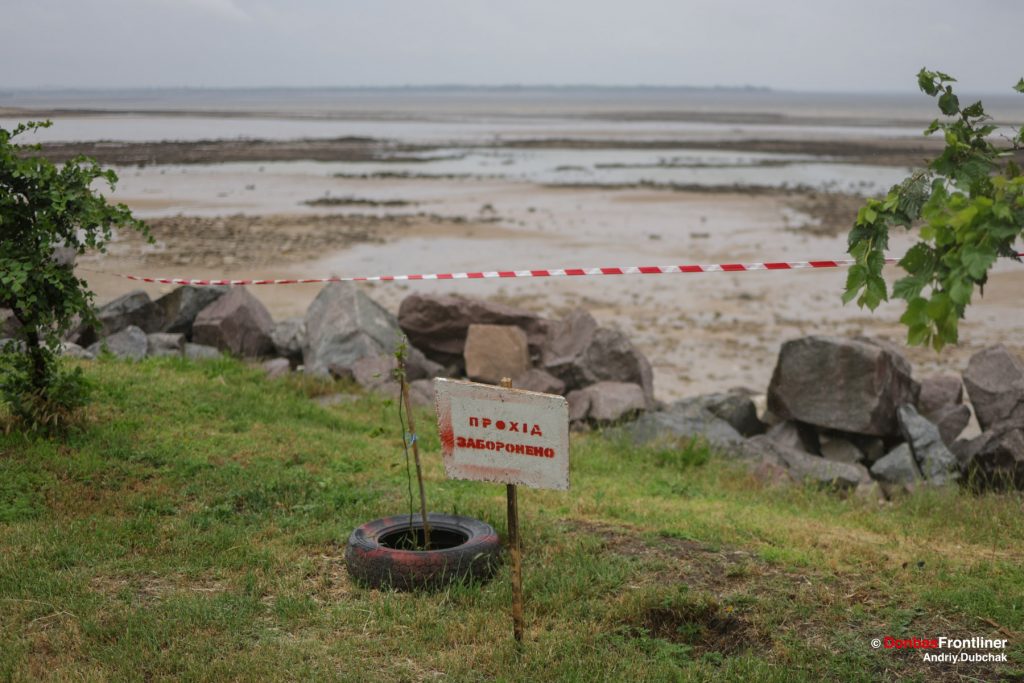
“They [the Russians] fired like this: first at the city—whoosh, whoosh, whoosh—oh, there it is, time to take shelter in the basement, we thought. Whoosh, whoosh, whoosh—then it flew toward the water. That’s it, a break, let’s have lunch and run to the grocery store or to the water spring,” says Tetiana. She lives on the second street from the riverbank. “Once, I went out to get water, and, oh God, how they shelled us! I abandoned my wheelbarrow and barely made it home when I saw that my neighbor had been killed.”
Tetiana says that this water spring saved her then—and continues to save her now. The bank used to be five to ten meters long; now, it is 120 meters. There has been no utility water in the pipes for three days. They promised to distribute drinking water. “Twenty-four liters per person,” they said. But it’s unclear for how long it’s supposed to last—maybe even for a month,” she adds.
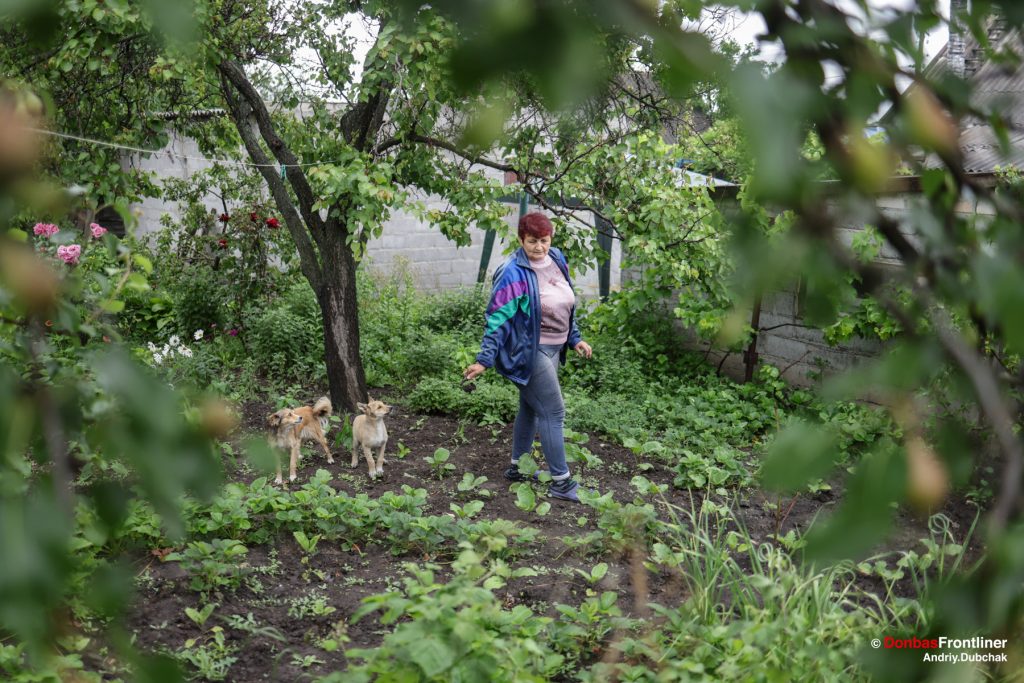
Tetiana stands in the middle of her vegetable patch. She grows strawberries, tomatoes, cucumbers, eggplants, peppers, and cabbage. She can still water them because she has built up a large water supply, “A drop here, a drop there, like in that nursery rhyme. That’s enough for today, but I’ll have to get more water tomorrow. A wheelbarrow, a stroller—and I’m off. My daughter says I should leave, but I’m not going anywhere. Not to the west of Ukraine, not anywhere. I just don’t want to. It’s all foreign to me, and this—this is my home.”
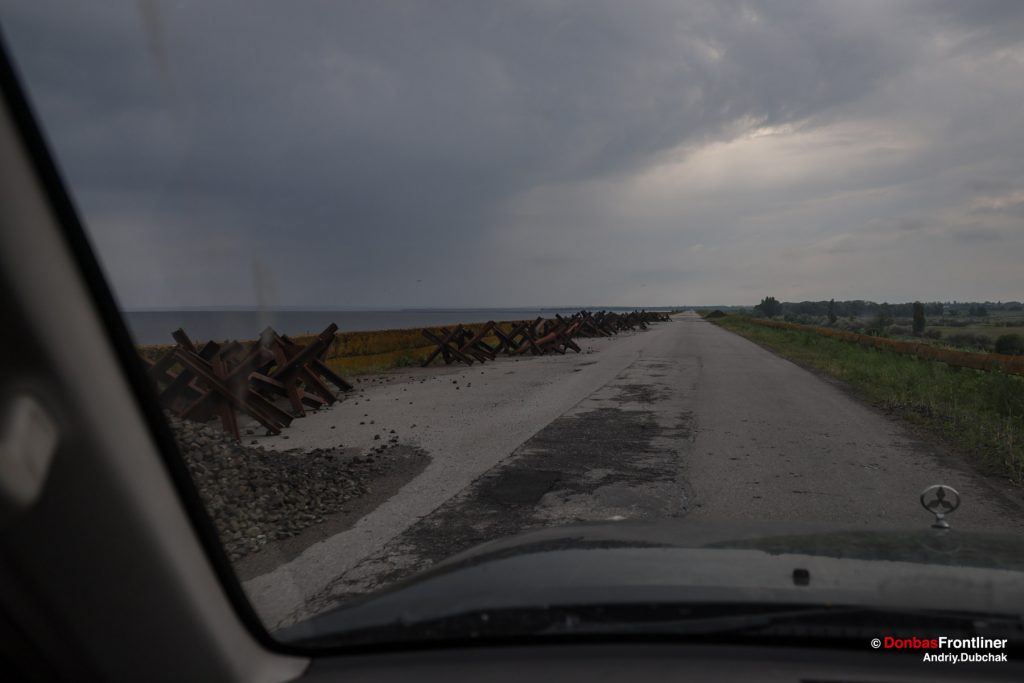
[1] The Soviet authorities blew up the dam for the first time in 1941 to slow down the advance of the German army.[b]
Text: Alona Savchuk / Photo and video: Andriy Dubchak
English translation: Hanna Leliv
Follow us: Instagram, Facebook, Twitter, YouTube, Telegram
